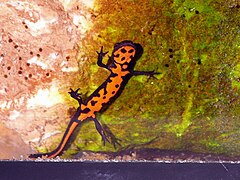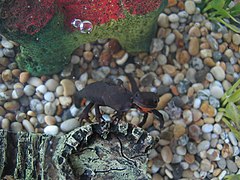
Salamanders are a group of amphibians typically characterized by their lizard-like appearance, with slender bodies, blunt snouts, short limbs projecting at right angles to the body, and the presence of a tail in both larvae and adults. All ten extant salamander families are grouped together under the order Urodela from the group Caudata. Salamander diversity is highest in eastern North America, especially in the Appalachian Mountains; most species are found in the Holarctic realm, with some species present in the Neotropical realm.

The smooth newt, European newt, northern smooth newt or common newt is a species of newt. It is widespread in Europe and parts of Asia, and has been introduced into Australia. Individuals are brown with a spotted underside that ranges in colour from orange to white. They reach an average length of 8–11 cm (3.1–4.3 in); males are larger than females. The newts' skins are dry and velvety when they are living on land, but become smooth when they migrate into the water to breed. Males develop a more vivid colour pattern and a conspicuous skin seam (crest) on their back when breeding.

Salamandridae is a family of salamanders consisting of true salamanders and newts. Salamandrids are distinguished from other salamanders by the lack of rib or costal grooves along the sides of their bodies and by their rough skin. Their skin is very granular because of the number of poison glands. They also lack nasolabial grooves. Most species of Salamandridae have moveable eyelids but lack lacrimal glands.
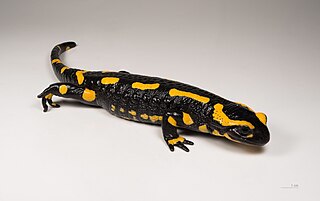
The fire salamander is a common species of salamander found in Europe.

The sword-tail newt, sword-tailed newt, yellow-bellied newt, or Okinawa newt is a species of true salamander from the Ryukyu Archipelago in Japan.
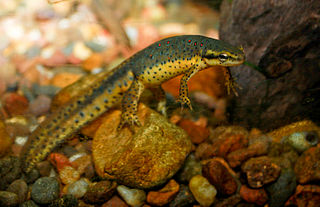
The eastern newt is a common newt of eastern North America. It frequents small lakes, ponds, and streams or nearby wet forests. The eastern newt produces tetrodotoxin, which makes the species unpalatable to predatory fish and crayfish. It has a lifespan of 12 to 15 years in the wild, and it may grow to 5 in (13 cm) in length. These animals are common aquarium pets, being either collected from the wild or sold commercially. The striking bright orange juvenile stage, which is land-dwelling, is known as a red eft. Some sources blend the general name of the species and that of the red-spotted newt subspecies into the eastern red-spotted newt.

The fire belly newt or fire newt is a genus (Cynops) of newts native to Japan and China. All of the species show bright yellow or red bellies, but this feature is not unique to this genus. Their skin contains a toxin that can be harmful if ingested.
The Chenggong fire belly newt is a species of newt of China. It is only known from its type locality, Shuitan in the Chenggong District of Yunnan.

The Japanese fire-bellied newt or Japanese fire-bellied salamander is a species of newt endemic to Japan. The skin on its upper body is dark and its lower regions bright red, although coloration varies with age, genetics, and region. Adults are 8 to 15 cm long. To deter predators, Japanese fire-bellied newts contain high levels of tetrodotoxin, a neurotoxin accumulated mainly from their diet.

Triturus is a genus of newts comprising the crested and the marbled newts, which are found from Great Britain through most of continental Europe to westernmost Siberia, Anatolia, and the Caspian Sea region. Their English names refer to their appearance: marbled newts have a green–black colour pattern, while the males of crested newts, which are dark brown with a yellow or orange underside, develop a conspicuous jagged seam on their back and tail during their breeding phase.

The genus Taricha consists of four species of highly toxic newts in the family Salamandridae. Their common name is Pacific newts, sometimes also western newts or roughskin newts. The four species within this genus are the California newt, the rough-skinned newt, the red-bellied newt, and the sierra newt, all of which are found on the Pacific coastal region from southern Alaska to southern California, with one species possibly ranging into northern Baja California, Mexico.
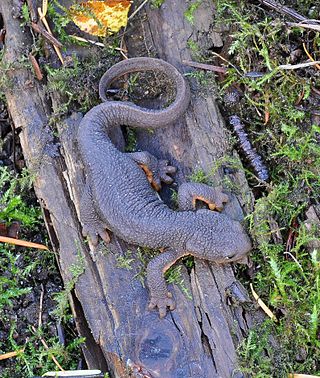
The rough-skinned newt or roughskin newt is a North American newt known for the strong toxin exuded from its skin.

The California newt or orange-bellied newt, is a species of newt endemic to California, in the Western United States. Its adult length can range from 5 to 8 in. Its skin produces the potent toxin tetrodotoxin.
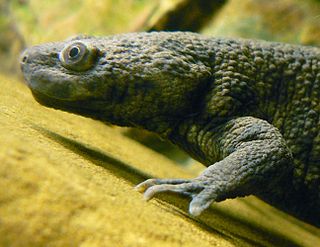
The Iberian ribbed newt, gallipato or Spanish ribbed newt is a newt endemic to the central and southern Iberian Peninsula and Morocco. It is the largest European newt species and it is also known for its sharp ribs which can puncture through its sides, and as such is also called the sharp-ribbed newt.

The Oriental fire-bellied toad is a small semiaquatic frog species found in northeastern Asia, where they primarily dwell in slow-moving bodies of water and temperate forests. Quite common throughout much of their range, these frogs have mild toxins that can be excreted through their skin, with their vibrant underbellies serving as a warning of this. While not a true toad, their green and black skin is covered in small tubercles, giving them a toadlike appearance. Their sounds, mainly produced by males during the mating season, are very unlike those of other frogs. While their population is in decline, their numbers are still high overall, with the International Union for Conservation of Nature (IUCN) rating them as a least-concern species. They are commonly kept as pets in land and water vivaria, as a relatively easy-to-care for species. They are also frequently used in scientific research, with their behavior, vocalizations, and learning skills all moderately studied.
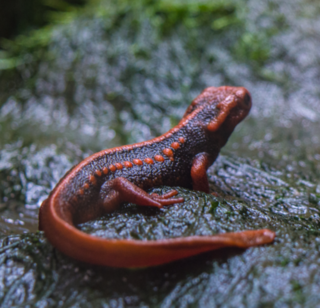
Tylototriton shanjing, the emperor newt, Mandarin newt or Mandarin salamander, is a highly toxic newt native to Yunnan and parts of South China. It is sometimes seen in private collections, and is sometimes available for sale at certain reptile and amphibian-specializing pet stores and occasionally through captive breeders.
The Dayang newt is a rare species of salamander in the family Salamandridae, endemic to China. It is known from Jiexi County in eastern Guangdong from where it was collected in 1936 and described as a new species in 1983. More recently, it has also been found from Dehua County in central Fujian.

Paramesotriton, also known as warty newts or Asian warty newts, is a genus of salamanders in the family Salamandridae. The genus is found in southwestern and southern China and in northern Vietnam. Most of the species are endemic to China, and the majority of them have been described recently, since 2008. The genus includes both pond and stream dwellers.

A newt is a salamander in the subfamily Pleurodelinae. The terrestrial juvenile phase is called an eft. Unlike other members of the family Salamandridae, newts are semiaquatic, alternating between aquatic and terrestrial habitats. Not all aquatic salamanders are considered newts, however. More than 100 known species of newts are found in North America, Europe, North Africa and Asia. Newts metamorphose through three distinct developmental life stages: aquatic larva, terrestrial juvenile (eft), and adult. Adult newts have lizard-like bodies and return to the water every year to breed, otherwise living in humid, cover-rich land habitats.
The Fuding fire belly newt is a rare species of newt in the family Salamandridae, endemic to China. It is only known from Fuding in northeastern Fujian, from the locality where it was described as a new species in 2010. Although it is genetically similar to the Chinese fire belly newt, it is morphologically more similar to the Dayang fire belly newt. The range of C. fudingensis is separate from both other species.


